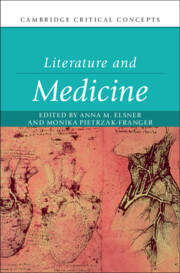Book contents
- Literature and Medicine
- Cambridge Critical Concepts
- Literature and Medicine
- Copyright page
- Dedication
- Contents
- Figures
- Contributors
- Acknowledgements
- Medico-Literary Pathways, Crossroads, and Side Streets
- Part I Origins: Histories
- Chapter 1 Guts, Hollows, and Coils
- Chapter 2 Medieval Affect, The Book of Margery Kempe, and Medical Treatments of the Embodied Soul
- Chapter 3 Epidemiological Language in Robert Burton’s The Anatomy of Melancholy
- Chapter 4 Illness and the Novel Aesthetics
- Chapter 5 Embodied Traumas in Twentieth- and Twenty-First-Century Literature
- Part II Developments: Forms
- Part III Applications: Politics
- Afterword
- Index
Chapter 5 - Embodied Traumas in Twentieth- and Twenty-First-Century Literature
from Part I - Origins: Histories
Published online by Cambridge University Press: 17 January 2024
- Literature and Medicine
- Cambridge Critical Concepts
- Literature and Medicine
- Copyright page
- Dedication
- Contents
- Figures
- Contributors
- Acknowledgements
- Medico-Literary Pathways, Crossroads, and Side Streets
- Part I Origins: Histories
- Chapter 1 Guts, Hollows, and Coils
- Chapter 2 Medieval Affect, The Book of Margery Kempe, and Medical Treatments of the Embodied Soul
- Chapter 3 Epidemiological Language in Robert Burton’s The Anatomy of Melancholy
- Chapter 4 Illness and the Novel Aesthetics
- Chapter 5 Embodied Traumas in Twentieth- and Twenty-First-Century Literature
- Part II Developments: Forms
- Part III Applications: Politics
- Afterword
- Index
Summary
This chapter examines the rise of trauma theory as a prevalent cultural and critical concept in the late twentieth and early twenty-first century. Key critiques of the concept – both in terms of its clinical and cultural dominance – are considered, particularly of its Western biases, and of the self-reinforcing bodies of trauma literature and criticism. The second half of the chapter considers a range of American trauma texts, with a particular focus on the work of Toni Morrison. These novels are examined for their complicated relationship to dominant theories of trauma representation, and for the way trauma texts increasingly respond to broader contemporary cultural and social concerns, including global warming.
Keywords
- Type
- Chapter
- Information
- Literature and Medicine , pp. 85 - 102Publisher: Cambridge University PressPrint publication year: 2024

